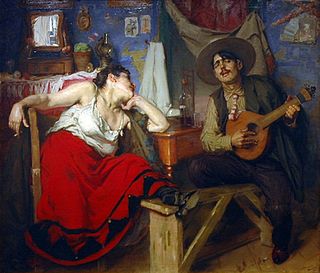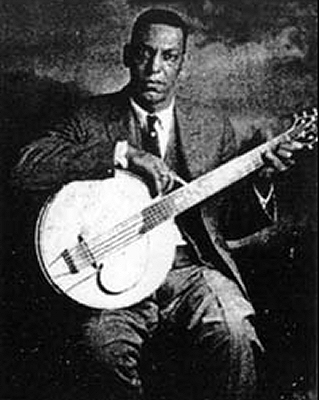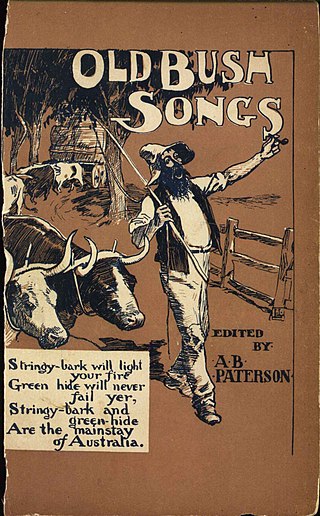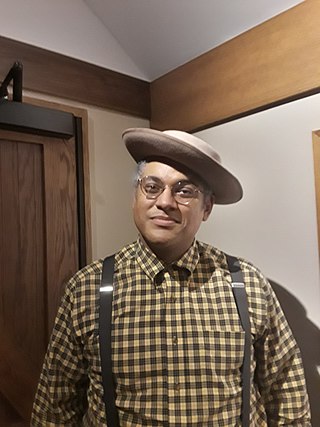A songster (pluralsongsters) is a musician, usually a singer; notably in the southern United States and the Salvation Army.
A songster (pluralsongsters) is a musician, usually a singer; notably in the southern United States and the Salvation Army.
A "songster" is a wandering musician, usually but not always African-American, of the type which first appeared in the late 19th century in the southern United States. The songster tradition both pre-dated and co-existed with blues music. It began soon after the end of slavery and the Reconstruction era in the United States, when African-American musicians became able to travel and play music for a living. [1] Black and white musicians shared the same repertoire and thought of themselves as "songsters" rather than "blues" musicians. [2]
Songsters generally performed a wide variety of folk songs, ballads, dance tunes, reels and minstrel songs. Initially, they were often accompanied by non-singing "musicianers", who often played banjo and fiddle. Later, as the guitar became more widely popular, the songsters often accompanied themselves. [3]
Songsters often accompanied medicine shows, which moved from place to place selling salves and elixirs. As entertainers, songsters had the task of enticing a public, to whom the concoctions were then offered. One published in 1886 by Professor Lorman, "The Great Disease Detective" of Philadelphia. "The Lorman's Indian Oil Star Specialty SONGSTER" announced on the booklet's title page that it contained "an entirely new and original collection of Songs now being sung nightly by the members of the above named excellent company, together with all the popular Songs of the day." Along with ads for Lorman's full range of medicines, the songster included a cast list introducing an "ever welcome Vocalist and Organist," a "celebrated Comedian and End Man," the "Funniest End-Man in the business in his Funny Sayings, Banjo Solos, and popular Songs of the Day," and the medicine-wagon driver, "admired for his dexterity in handling the Ribbons on the Golden Chariot." Song lyrics in the booklet include such tunes as "You Can't Do It, You Know" (music by George Schleiffarth, lyrics by Nat C. Goodwin), "The Letter That Never Came," (sung by Billy Cronin in the play One of the Bravest. [4] As these shows declined, and listening to recorded music and dancing in juke joints and honky tonks became more popular, so the older songster style became less fashionable.
Songsters had a notable influence on blues music, which developed from around the turn of the 20th century. However, there was also a change in song styles. Songsters often sang composed songs or traditional ballads, frequently about legendary heroes or characters such as "Frankie and Johnny" and "Stagger Lee". Blues singers, in contrast, tended to invent their own lyrics (or recycle those of others) and develop their own tunes and guitar (or sometimes piano) playing styles, singing of their own lives and shared emotional experiences.
Many of the earliest recordings of what is now referred to as the blues were made by songsters who commanded a much wider repertoire, often extending to popular Tin Pan Alley songs of the day as well as the "authentic" country blues. There is a growing view among scholars [5] that the distinction made by experts such as Alan Lomax between "deep" blues singers and "songsters" is an artificial one, and that in fact most of the leading archetypal blues artists, including Robert Johnson and Muddy Waters, performed a wide variety of music in public, but recorded only that proportion of their material which was seen by their producers as original or innovative.
In The Salvation Army the term "songster" refers to an adult chorister in a Salvation Army choir, formally called a "Songster Brigade". [6] The plural form "songsters" is commonly used to refer to a Songster Brigade when preceded by the definite article. Songsters commonly sing in worship services and can be used to teach congregations new songs.
Songster Brigades are led by a Songster Leader, who is assisted by a Deputy Songster Leader. [6] Brigades are helped administratively by a Songster Sergeant, Songster Secretary and a Songster Treasurer who all assist the Songster Leader in the organization of the brigade. There is also a Songster Librarian, who handles and organizes the music, and a Songster Pianist.
Individual Salvation Army corps (churches) commonly have their own Songster Brigade, while others have been formed to represent wider regions or countries, such as the International Staff Songsters.

Blues is a music genre and musical form that originated amongst African-Americans in the Deep South of the United States around the 1860s. Blues has incorporated spirituals, work songs, field hollers, shouts, chants, and rhymed simple narrative ballads from the African-American culture. The blues form is ubiquitous in jazz, rhythm and blues, and rock and roll, and is characterized by the call-and-response pattern, the blues scale, and specific chord progressions, of which the twelve-bar blues is the most common. Blue notes, usually thirds, fifths or sevenths flattened in pitch, are also an essential part of the sound. Blues shuffles or walking bass reinforce the trance-like rhythm and form a repetitive effect known as the groove.

Bluegrass music is a genre of American roots music that developed in the 1940s in the Appalachian region of the United States. The genre derives its name from the band Bill Monroe and the Blue Grass Boys. Like mainstream country music, it largely developed out of old-time music, though in contrast to country, it is traditionally played exclusively on acoustic instruments and also kept its roots in traditional English, Scottish and Irish ballads and dance tunes, as well as incorporating blues and jazz. It was further developed by musicians who played with Monroe, including 5-string banjo player Earl Scruggs and guitarist Lester Flatt. Bill Monroe once described bluegrass music as, "It's a part of Methodist, Holiness and Baptist traditions. It's blues and jazz, and it has a high lonesome sound."

In popular music, a cover version, cover song, remake, revival, or simply cover is a new performance or recording by a musician other than the original performer or composer of the song. Originally, it referred to a version of a song released around the same time as the original in order to compete with it. Now, it refers to any subsequent version performed after the original.

A singer-songwriter is a musician who writes, composes, and performs their own musical material, including lyrics and melodies. In the United States, the category is built on the folk-acoustic tradition with a guitar, although this role has transmuted through different eras of popular music. Traditionally, these musicians would write and sing songs personal to them. Singer-songwriters often provide the sole musical accompaniment to an entire song. The piano is also an instrument of choice.

Fado is a music genre which can be traced to the 1820s in Lisbon, Portugal, but probably has much earlier origins. Fado historian and scholar Rui Vieira Nery states that "the only reliable information on the history of fado was orally transmitted and goes back to the 1820s and 1830s at best. But even that information was frequently modified within the generational transmission process that made it reach us today."
Melisma is the singing of a single syllable of text while moving between several different notes in succession. Music sung in this style is referred to as melismatic, as opposed to syllabic, in which each syllable of text is matched to a single note. An informal term for melisma is a vocal run. The term roulade is also sometimes used interchangeably with melisma.

The term American folk music encompasses numerous music genres, variously known as traditional music, traditional folk music, contemporary folk music, vernacular music, or roots music. Many traditional songs have been sung within the same family or folk group for generations, and sometimes trace back to such origins as the British Isles, Mainland Europe, or Africa. Musician Mike Seeger once famously commented that the definition of American folk music is "...all the music that fits between the cracks."
The U.S. state of North Carolina is known particularly for its history of old-time music. Many recordings were made in the early 20th century by folk song collector Bascom Lamar Lunsford. Influential North Carolina country musicians such as the North Carolina Ramblers and Al Hopkins helped solidify the sound of country music in the late 1920s, while influential bluegrass musicians such as Earl Scruggs and Doc Watson came from North Carolina. Arthur Smith had the first nationally syndicated television program which featured country music. He composed "Guitar Boogie", the all-time best selling guitar instrumental, and "Dueling Banjos", the all-time best selling banjo composition. Country artist Eric Church from the Hickory area, has had multiple No. 1 albums on the Billboard 200, including Chief in 2011. Both North and South Carolina are a hotbed for traditional country blues, especially the style known as the Piedmont blues. Elizabeth Cotten, from Chapel Hill, was active in the American folk music revival.

William Henry "Papa Charlie" Jackson was an early American bluesman and songster who accompanied himself with a banjo guitar, a guitar, or a ukulele. His recording career began in 1924. Much of his life remains a mystery, but his draft card lists his birthplace as New Orleans, Louisiana, and his death certificate states that he died in Chicago, Illinois, on May 7, 1938.

Old-time music is a genre of North American folk music. It developed along with various North American folk dances, such as square dancing, contra dance, clogging, and buck dancing. It is played on acoustic instruments, generally centering on a combination of fiddle and plucked string instruments, most often the banjo, guitar, and mandolin. Together, they form an ensemble called the string band, which along with the simple banjo–fiddle duet have historically been the most common configurations to play old-time music. The genre is considered a precursor to modern country music.

The colonial history of the United States began in 1607 with the colonization of Jamestown, Virginia. Music of all genres and origins emerged as the United States began to form. From the Indigenous spiritual music to the African banjos, music in the United States is as diverse as its people. In New England, the music was very religious and was vitally important in the rising of American music. The migration of people southward led to the settling of the Appalachian Mountains. There many poor Europeans inhabited and brought country blues and fiddling. As music spread, the religious hymns were still just as popular. The first New England School, Shakers, and Quakers, which were all music and dance groups inspired by religion, rose to fame. In 1776, St. Cecilia Music Society opened in the Province of South Carolina and led to many more societies opening in the Northern United States. African slaves were brought to the United States and introduced the music world to instruments like the xylophone, drums and banjo. The diverse music of the United States comes from the diverse type of people who first colonized this country.
Berber music refers to the musical traditions of the Berbers, a diverse grouping of distinct ethnic groups indigenous to North Africa who predate the arrival of Arabs in the Arab migration to the Maghreb. Their main connections are identified by their usage of the mostly mutually unintelligible Berber languages. Berber music varies widely across North Africa. It is stylistically diverse, with songs being predominantly African rhythms and a stock of oral literature.

Appalachian music is the music of the region of Appalachia in the Eastern United States. Traditional Appalachian music is derived from various influences, including the ballads, hymns and fiddle music of the British Isles, and to a lesser extent the music of Continental Europe.
Richard Daniel Burnett was an American folk musician and songwriter from Kentucky.

Jim Jackson was an American blues and hokum singer, songster, and guitarist, whose recordings in the late 1920s were popular and influential on later musicians.

The bush ballad, bush song, or bush poem is a style of poetry and folk music that depicts the life, character and scenery of the Australian bush. The typical bush ballad employs a straightforward rhyme structure to narrate a story, often one of action and adventure, and uses language that is colourful, colloquial, and idiomatically Australian. Bush ballads range in tone from humorous to melancholic, and many explore themes of Australian folklore, including bushranging, droving, droughts, floods, life on the frontier, and relations between Indigenous and non-Indigenous Australians.
"Cumberland Gap" is an Appalachian folk song that likely dates to the latter half of the 19th century and was first recorded in 1924. The song is typically played on banjo or fiddle, and well-known versions of the song include instrumental versions as well as versions with lyrics. A version of the song appeared in the 1934 book, American Ballads and Folk Songs, by folk song collector John Lomax. Woody Guthrie recorded a version of the song at his Folkways sessions in the mid-1940s, and the song saw a resurgence in popularity with the rise of bluegrass and the American folk music revival in the 1950s. In 1957, the British musician Lonnie Donegan had a No. 1 UK hit with a skiffle version of "Cumberland Gap".

Dominique Flemons is an American old-time music, Piedmont blues, and neotraditional country multi-instrumentalist, singer, and songwriter. He is a proficient player of the banjo, fife, guitar, harmonica, percussion, quills, and rhythm bones. He is known as "The American Songster" as his repertoire of music spans nearly a century of American folklore, ballads, and tunes. He has performed with Mike Seeger, Joe Thompson, Martin Simpson, Boo Hanks, Taj Mahal, Old Crow Medicine Show, Guy Davis, and The Reverend Peyton's Big Damn Band.

The International Staff Songsters (ISS) is the principal choir of the Salvation Army. Based in London, UK, the group performs Christian choral music in concerts, worship services and television and radio broadcasts, and has recorded more than 50 albums since its inauguration.